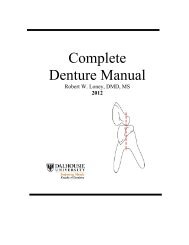RPD Manual 11 - Removable Prosthodontics - Dalhousie University
RPD Manual 11 - Removable Prosthodontics - Dalhousie University
RPD Manual 11 - Removable Prosthodontics - Dalhousie University
You also want an ePaper? Increase the reach of your titles
YUMPU automatically turns print PDFs into web optimized ePapers that Google loves.
Direct and Indirect Retainers - 44<br />
Requirements of Direct Retainers<br />
All clasp assemblies should meet the following requirements:<br />
1. Support - resistance to gingival displacement (occlusal rests)<br />
2. Reciprocity - resistance to orthodontic movement of teeth using reciprocal arms or<br />
elements placed against guiding planes. During placement and removal of the partial<br />
denture the retentive arm flexes over the height of contour and generates energy. At this<br />
point the rigid reciprocal arm should contact the guiding plane and prevent orthodontic<br />
movement from taking place.<br />
3. Stability - resistance to lateral movement (reciprocal arms, minor connectors)<br />
4. Retention - retentive arms located in undercuts on the abutments<br />
5. Encirclement of greater than 180° of the tooth - prevents the prosthesis from moving<br />
away from the tooth<br />
6. Passivity - at rest, a direct retainer should not exert force against a tooth<br />
Wherever possible direct retainers should be selected to fit the existing teeth. This is preferable<br />
to preparing teeth to fit a particular clasp design. It may be possible to select a different clasp<br />
design to meet the retentive requirements for a partial denture. Nonetheless, judicious tooth<br />
preparation should not be avoided at all costs, since it can immeasurably improve prosthesis<br />
biomechanics.<br />
Factors affecting the magnitude of retention<br />
1. Size of the angle of convergence.















